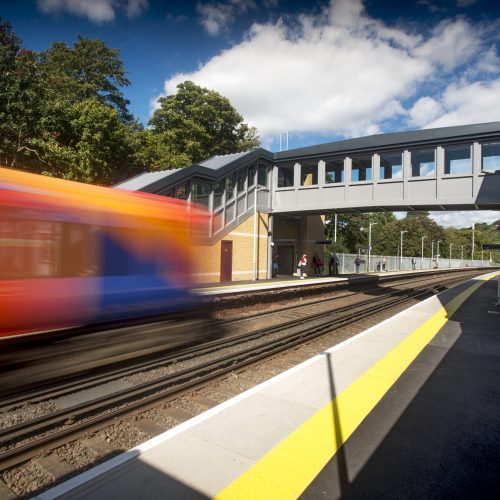Providing an obstacle free access route from passenger ‘drop off’ to train is a requirement for all rail infrastructure operators.
At Octavius we have designed and installed over thirty Access for All (AfA) rail station upgrades and currently have £65m of AfA projects in various stages of delivery: either recently entered passenger service, under construction or in design development.
From this experience we have really learned and now understand the critical elements to guarantee success in the delivery of Access for All and Step Free Access (SfA) projects within live passenger environments. Octavius has applied this learning to continuously improve and adopt the very best practice into each new design and chosen methodologies for every new AfA and SfA project.
There are many facets in identifying the most efficient and effective solutions. Solutions that minimise disruption to passengers, neighbouring residents and businesses. It is crucial to take due cognisance and allow for the conservation processes to both protect the heritage of the stations which the AfA schemes are to be blended into and the project timescales. Other facets include caring for the local ecology and environment, energy and power requirements, ongoing maintenance and whole life costs. Not forgetting the challenges associated with meeting wide-ranging demands of a typically diverse range of stakeholder needs which makes each project location a unique one with specific risks and challenges.
Critical AfA Success Factors
Some of the critical elements to be considered to ensure the successful delivery of an AfA or SfA project are outlined below.
- Clear and concise stakeholder agreements – developing transparent agreements to align expectations and responsibilities. Stakeholders that play no part in the AfA project funding can often have substantial influence on project costs and programme both during feasibility development and implementation. Establishing close and informative relationships with the residents and business owners adjacent to the station worksites is crucial to the project success. Whilst these communities are potential benefactors from improved accessibility, they are also a group most impacted during construction. Keeping these communities updated in real time of the work planned, particularly in relation to those unavoidable nighttime activities or specific noisy and disruptive operations and regularly reporting progress is essential.
- Identifying and developing the minimum viable product – with all the major project elements there is a wide range of options that can significantly impact project value. For example, lift selection can seriously impact total project cost, as can the choices of cladding, finishes and ground conditions. The presence of existing safety critical services might dictate that a longer link bridge span, or a more complex foundation solution will be more cost effective than undertaking complex protection and diversion measures. The objective is to create the essential functionality that meets the AfA project goals most efficiently. Innovations that improved quality, cost and programme are founded in the adoption of modern methods of construction. Solutions that simplify methodologies, lever the benefits of modular design, the use of standardise components and digital technologies play a significant role in achieving the very best most viable solutions.
- Feasible designs – creating practical and achievable designs tailored to project constraints. Crucial here is being absolutely clear what the major cost drivers are. Typically, these cost drivers have a greater influence on the best solution than what might be considered the simplest and cheapest design at the outset. Careful management of and removal of the common risks associated with the interfaces between organisations, designers and specialist trades is also essential in developing the most feasible design.
- Certainty of project scope – clearly defining project boundaries to ensure alignment and focus. Instructing scope changes during mobilisation, detailing, planning and implementation will almost certainly increase project risks and costs, delay the programme and put unnecessary pressure on project teams to recover delays and further increase productivity to compensate.
- Best value to meet efficiency targets – balancing cost, quality and time to maximise project efficiency. Get this right and you have a solution that performs to meet the output specification for the most cost-effective price that can be completed in the optimum time.
- Right first-time delivery – ensuring accurate execution to avoid rework and delays. This means people having the right information, in a timely manner, the right level of skilled resources, clarity and clear briefing of safe methodologies, followed up with effective test, inspection and handover plans.
Summary from Octavius Rail Director
Rail Operations Director Matt Broxholme summarises “The sheer scale and number of projects we have delivered in providing step free solutions has given us a rich source of learning, knowledge and experience that allows us to continually improve, raise the bar to remove risk and provide certainty of outcomes for our customers.
In my experience no two AfA projects are the same and the construction phase, once the scope is finalised, is often the easiest. Positively managing the complex and different expectations of funders, local stakeholders, authorities and operators early in the process is essential. If not carefully and sensitively addressed, lack of clarity and agreement can become mission critical to meeting key outcomes.
An AfA project delivered 10 years ago is very different from the requirements demanded now. Today’s projects have a myriad of additional scope requirements, lift and footbridge types, increased security systems not to mention obtaining the energy required from local power networks. An AfA project now demands more design stage deliverables, in our early projects the requirement would be significantly less, this change adds resource, time and cost into the process.
The advantage I believe we have in Octavius is the vast depth of knowledge and learning that we have acquired as an AfA market leader. This gives us a unique and specialist understanding of the drivers of cost, risk and certainty. Key process initiatives such as “Design to Cost” are introduced as we further develop and refine our own AFA Productivity Model to support industry focus on improving AfA programme performance through Control Period 7.”
This article originally appeared in RIA’s ‘The Journey to Equality: Creating a Railway for All’ report. Click here to access the report in full.


